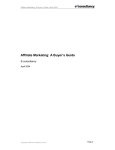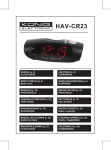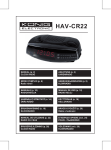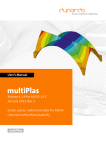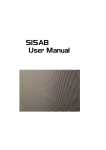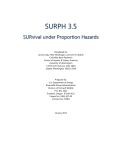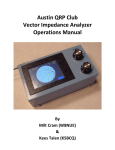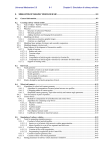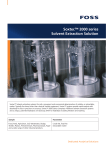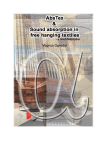Download D4.7 – Basic global prediction tool and user manual
Transcript
EC Contract No. FP7 - 284877 Virtual certification of acoustic performance for freight and passenger trains D 4.7 – Basic global prediction tool and user manual (final update of D4.2) Due date of deliverable: 31/05/2014 Actual submission date: 30/06/2014 Leader of this Deliverable: David Thompson, Giacomo Squicciarini, ISVR Reviewed: Y Document status Revision Date Description 1 06/06/2014 First issue 2 30/06/2014 Final version after TMT approval Project co-funded by the European Commission within the Seven Framework Programme (2007-2013) Dissemination Level X PU Public PP Restricted to other programme participants (including the Commission Services) Restricted to a group specified by the consortium (including the Commission Services) Confidential, only for members of the consortium (including the Commission Services) RE CO Start date of project: 01/10/2011 Collaborative project Duration: 36 months EC Contract No. FP7 - 284877 EXECUTIVE SUMMARY The present document is an update of Deliverable 4.2. It contains an updated description of the ACOUTRAIN software for pass-by and standstill noise simulation developed within Task 4.2 and explains the theory implemented in the software to calculate the noise propagation of a series of moving (or standstill) sources above an impedance ground. The objective of this task is to implement a framework for a simple global simulation model based on the minimum requirements and input/output data defined in Task 4.1. As input this global simulation tool takes data describing the various sources on a train (sound powers, possibly directivities) along with geometrical data about the sources, the receiver and the ground properties. From these input data predicts the evolution of the pass-by sound level (overall and in one-third octave bands). The development of this simulation tool is based on the required input/output defined in Task 4.1 The purpose of this simulation tool is to demonstrate the method of prediction required as part of the virtual certification process so that third parties can use it. Full details of the theory implemented in the software are given in an appendix. ACT-WP4-D-ISV-022-02 Page 2 of 43 30/06/2014 EC Contract No. FP7 - 284877 TABLE OF CONTENTS Executive Summary ...................................................................................................................... 2 List of Figures ............................................................................................................................... 5 1 Introduction ........................................................................................................................... 6 2 Overview ............................................................................................................................... 6 2.1 3 Frame of reference ......................................................................................................... 6 Add a new vehicle ................................................................................................................. 7 3.1 Add Sources ................................................................................................................... 9 4 Manage the train ................................................................................................................. 11 5 Add rolling noise.................................................................................................................. 12 6 Test site definition ............................................................................................................... 13 7 Operating conditions ........................................................................................................... 14 8 Receivers ............................................................................................................................ 14 9 Calculations and results ...................................................................................................... 15 10 File management ................................................................................................................ 16 11 File format for uploading data .............................................................................................. 16 11.1 Sound powers ........................................................................................................... 16 11.1.1 Single point source ................................................................................................ 17 11.1.2 Area Source........................................................................................................... 17 11.1.3 Box source............................................................................................................. 17 11.1.4 Rolling noise sources ............................................................................................. 18 11.2 Directivity .................................................................................................................. 19 11.2.1 Monopole-to-dipole ratio ........................................................................................ 19 11.2.2 User defined directivity........................................................................................... 19 11.3 Frequency dependent aerodynamic coefficient ......................................................... 20 11.4 Roughness ................................................................................................................ 21 11.5 Receivers .................................................................................................................. 21 References ................................................................................................................................. 22 Appendix A: Theory .................................................................................................................... 23 A.1 Time evolution of the source ......................................................................................... 26 A.2 Time evolution of the image source .............................................................................. 28 A.3 Doppler effect ............................................................................................................... 30 A.4 Sound pressure contribution of the source .................................................................... 30 ACT-WP4-D-ISV-022-02 Page 3 of 43 30/06/2014 EC Contract No. FP7 - 284877 A.5 Sound pressure contribution of the image source ......................................................... 30 A.6 Total contribution .......................................................................................................... 30 A.7 Narrow band conversion of one-third octave band input ............................................... 31 A.8 Ground reflection .......................................................................................................... 31 Delany and Bazley model .................................................................................................... 31 Miki model ........................................................................................................................... 32 Hamet and Berangier model................................................................................................ 32 Reflection coefficient ........................................................................................................... 33 A.9 Source characterisation ................................................................................................ 33 Monopole-to-dipole ratio...................................................................................................... 33 Custom directivity ................................................................................................................ 33 Area source......................................................................................................................... 34 Aerodynamic source ........................................................................................................... 34 Box source .......................................................................................................................... 34 A.10 Point sources for rolling noise modelling ................................................................... 34 Wheel.................................................................................................................................. 34 Rail...................................................................................................................................... 35 Sleeper ............................................................................................................................... 35 Other source distributions ................................................................................................... 35 References used in Appendix A .................................................................................................. 36 APPENDIX B: Main calculation routines from the software ......................................................... 37 B.1 Geometrical data .......................................................................................................... 37 B.2 Sound pressure calculation ........................................................................................... 39 B.3 Ground models ............................................................................................................. 41 ACT-WP4-D-ISV-022-02 Page 4 of 43 30/06/2014 EC Contract No. FP7 - 284877 LIST OF FIGURES Figure 1: Frame of reference. ....................................................................................................... 7 Figure 2: Add a new vehicle into the train. .................................................................................... 7 Figure 3: Describing new vehicle parameters................................................................................ 8 Figure 4: Right click on the wheelset to edit its properties. ............................................................ 9 Figure 5: Defining new source parameters. ................................................................................. 10 Figure 6: Right click on the vehicle body to edit all vehicle properties, including sources related to the vehicle. .......................................................................................................................... 11 Figure 7: Defining a rolling noise input for a specific wheelset type. ............................................ 12 Figure 8: Test site geometry and ground impedance properties. ................................................. 13 Figure 9: Example of receivers position for standstill calculation. ................................................ 14 Figure 10: Results view. .............................................................................................................. 16 Figure 11: Face numbering for the box source. ........................................................................... 18 ACT-WP4-D-ISV-022-02 Page 5 of 43 30/06/2014 EC Contract No. FP7 - 284877 1 INTRODUCTION The present deliverable summarises the outcomes of Task 4.2. The objective of this task was to implement a framework for a simple global simulation model. As input this global simulation tool takes data describing the various sources on a train (sound powers, directivities) along with geometrical data about the sources, the receiver and the ground properties. From these input data it predicts the evolution of the pass-by sound level (overall and in one-third octave bands). Deliverable 4.2 [1] already described the software in its version VBeta1.7 (2013). Meanwhile, in order to meet the requirements of the ongoing ACOUTRAIN project, some updates have been made to the software. The aim of this deliverable is to describe the latest version of the software and to give full details of the theory behind it. The main text is principally an update of Deliverable 4.2, appendix A is dedicated to the theory of moving sources above an impedance ground while appendix B reports the most relevant parts of the code. The development of this simulation tool is based on the required input/output defined in Deliverable 4.1[2]. This document corresponds to Version 1.0 of the ACOUTRAIN software released in June 2014. A 32 bit (or 64 bit) compiled version of the software is provided under a license agreement: after installing the 8.0 Matlab 32 bit runtime compiler launch the executable file to run the software. 2 OVERVIEW The software works by defining noise sources which are each associated with a vehicle. Several vehicles are assembled to make a train. Noise sources may be associated with rolling noise or other types of noise source. They are defined in terms of their sound power in onethird octave bands and a directivity. The receiver locations are defined as well as the ground properties. Then sound pressure can be calculated either at stand-still or during a train passby. Note that the geometry of the vehicle displayed in the figures is for visualisation purposes only and the train body does not modify the acoustic propagation in any way. In other words there are no shielding or diffraction effects directly considered in the software. 2.1 FRAME OF REFERENCE The main Cartesian frame of reference is defined as follows (see Figure 1): • • • x axis positive direction as the positive train velocity. z axis vertical direction positive upwards. y axis defined according to right handed orientation. The origin of the x axis is set at the end of the last vehicle of a train, y origin is at the middle of the train and the vertical origin is at the top of the rail. Spherical coordinates are also used. To describe the position of a point in space according to a spherical coordinate system the convention of Figure 1 (dashed lines) is adopted, where θ is the polar angle, ϕ the azimuthal angle and r the distance between the point and the origin. ACT-WP4-D-ISV-022-02 Page 6 of 43 30/06/2014 EC Contract No. FP7 - 284877 Figure 1: Frame of reference. 3 ADD A NEW VEHICLE When starting a new model the first vehicle has to be defined and added to the train. From the menu bar press “Create” and then “add Vehicle” (see Figure 2). The window shown in Figure 3 appears. Figure 2: Add a new vehicle into the train. ACT-WP4-D-ISV-022-02 Page 7 of 43 30/06/2014 EC Contract No. FP7 - 284877 Figure 3: Describing new vehicle parameters. Here it can be decided whether to create a new vehicle or load an existing one. In order to create a new one the main parameters have to be inserted in the “Define vehicle geometry” panel. Once the parameters have been inserted press the “ok” button located inside this panel. The axes on the right are then updated and other panels are activated. Within ACOUTRAIN rolling noise is associated with wheelsets. The wheelsets are characterized by their position on the vehicle (x coordinates of the wheelsets relative to the first end of the vehicle) and by their type (or the set they belong to). Before adding a wheelset it is therefore necessary to create a wheelset type. When starting a new model no types are available. They can be created through the functionalities given in the “wheelsets type” panel. The wheelset type contains the information about the wheel radius and about the results coming from TWINS calculation (these will be loaded later on, see Section 5). To create a new “type” enter the wheel radius associated with it and the name of the set, then press the button “Create new”. The list of available sets will be updated. The existing sets can be then edited or deleted as required. When at least one set exists the wheelsets can be added to the vehicle. Two modes of adding wheelsets are available: standard and one-by-one. The standard mode allows the number of wheelsets existing on the vehicle to be entered and then the bogie wheelbase and bogie centre distance to be specified. In this mode only two or four wheelsets can be allocated to a vehicle. Note that if two wheelsets are added the software will ignore the bogie wheelbase information. ACT-WP4-D-ISV-022-02 Page 8 of 43 30/06/2014 EC Contract No. FP7 - 284877 When pressing the button “ok” the software asks for the wheelset type that they belong to before updating the vehicle. Both the wheelset position and type can be edited using the context-menu available when right-clicking on each wheelset in the axes (see Figure 4). The second mode of adding wheelsets consists in adding them one-by-one using the button “Add wheelset”. Pantographs can also be added to the vehicle. The pantograph to be added at this stage does not represent its acoustic properties but is simply a visualisation on the vehicle image that can help with positioning sources. Figure 4: Right click on the wheelset to edit its properties. 3.1 ADD SOURCES The software allows now some general sources to be added. The “add sources” button opens the window shown in Figure 5. First the frequency range has to be set. All the files to be loaded within this window refer to the specific source which is being defined and must match this frequency range. ACT-WP4-D-ISV-022-02 Page 9 of 43 30/06/2014 EC Contract No. FP7 - 284877 Figure 5: Defining new source parameters. Different source types are available: • • • As a default setting a “Point Source” is proposed. Sound power can be loaded from a file according to the format shown in Section 11; by default a unit power spectrum is proposed. Alternatively the “Area Source” will distribute point sources on a given area. As a third option the user can select the “box source” model. In this case a box is defined in the model and each face can have one source located at its centre radiating in the halfspace exterior to the box. In this case the user has to load a different file to define the acoustic power of each face (see Section 11.1.3). For all these sources the “aerodynamic source” option can be chosen. In this case a dependence of noise level with speed has to be defined. The source directivity is defined in terms of a ratio between monopole and dipole source strengths. The monopole-to-dipole ratio can be modified by the “Reset all” button in the “Standard directivity” panel. Otherwise a different ratio value can be set for each frequency band by loading an appropriate text file (see Section 11). The dipole axis can be modified by rotating it around the x axis and then around z axis from its original position (parallel to the z axis). ACT-WP4-D-ISV-022-02 Page 10 of 43 30/06/2014 EC Contract No. FP7 - 284877 The directivity can also be described by the user in a text file in terms of noise levels at certain angles and radii in a spherical coordinate system (see Section 11). By pressing “ok” (bottom right) the current window is closed and the previous one is restored. The sources that have been created can be positioned on the vehicle by left-clicking on the vehicle axes. Once the sources have been positioned, a context-menu allows their position to be modified: they can be switched off/on, deleted or edited as necessary. To help with the right-clicking on the sources, the vehicle body can be temporarily made invisible. All the sources and wheelsets type can be listed with the “Source list” button (top right). The procedure of adding sources on a vehicle can be repeated as many times as necessary. The vehicle can be saved as a Matlab-format file and loaded again for use in other models. 4 MANAGE THE TRAIN When all the required wheelsets and sources have been added, the vehicle is ready to be placed in the train. After entering the vehicle position press the button “ok” (bottom right), the current window is closed and the main one restored with the new vehicle available. By right-clicking on this one several functionalities are displayed, the vehicle can be copied, edited, moved, mirrored or deleted (see Figure 6). Figure 6: Right click on the vehicle body to edit all vehicle properties, including sources related to the vehicle. The “Copy” option will copy the vehicle and position it to the right of the existing one. ACT-WP4-D-ISV-022-02 Page 11 of 43 30/06/2014 EC Contract No. FP7 - 284877 To move a vehicle from its position in a train to another one, choose the “Move” option from the menu and then left-click on the gap between two other vehicles where the selected vehicle has to be moved. A vehicle can be mirrored relative to the y-z plane passing through its centre. By choosing the “Edit” option the window used to create the vehicle is reopened and all the described functionalities are again available. The option “List sources” will again display all the sources and wheelsets of the vehicle. 5 ADD ROLLING NOISE The “add rolling noise” item in the “Create” menu allows the rolling noise power components to be attached to wheelset types that have already been defined (Figure 7). Within this GUI the sound power levels can be visualised in terms of acoustic power. If necessary they can be removed from the model. Figure 7: Defining a rolling noise input for a specific wheelset type. There are two different ways to load sound power into the software, in both the cases the sound powers are meant to be calculated with a unit (1 m) roughness input. • Loading single power files. Wheel power, rail power and sleeper power .txt files can be selected after clicking the button “Load text files”. The file format is similar to that used for the point sources, with the peculiarity that the first string in the file must be “wheel”, “rail” or “sleep” according to the power component the file refers to. ACT-WP4-D-ISV-022-02 Page 12 of 43 30/06/2014 EC Contract No. FP7 - 284877 • Selecting a TWINS folder. If the outputs of the software TWINS are available, then the “Select TWINS dir” button allows the user to browse in order to select a TWINS model folder (outputs from TWINS 2.4 have been tested so far). Sound powers will be detected inside the folder and loaded along with the Track Decay Rates. The contact filter is always accounted for, allowing for the train speed set in the “Operating Conditions” window (see Section 7 below), while roughness can be set via the radio buttons: • • • • Unit: 1 µm roughness in each wavelength band; TSI: the limit curve defined in TSI is adopted; Load one file: the combined (wheel and rail) roughness is contained in one single file (extension .to). See section 11 for format explanation Load two files: wheel roughness and rail roughness are loaded separately; the software will add them up. The same .to format file is to be used. Note that the sound power levels will not be uploaded until the “Attach acoustic power” button is pressed. 6 TEST SITE DEFINITION To define the test site, the “Test Site Definition” item in the “Create” menu gives access to the GUI showed in Figure 8. The geometry can be set only in terms of the vertical distance between the main reflecting ground and the top of the rail (i.e. the vertical origin of the reference system). The ground can furthermore be defined as rigid or reflecting (Delany Bazley, Miki and HametBerangier impedance models are implemented in the code). Calculations without ground can also be performed. Figure 8: Test site geometry and ground impedance properties. ACT-WP4-D-ISV-022-02 Page 13 of 43 30/06/2014 EC Contract No. FP7 - 284877 7 OPERATING CONDITIONS To define the operating conditions of the train the type of the test has to be defined (“Operating conditions” in “Create” menu). Passby at a constant speed or stand-still mode are allowed. When considering the passby mode the test duration can be modified here. The test duration will also define the relative position between the train and the x coordinates of the receivers. The receivers are set to be in front of the middle of the train at half of the test duration time. This parameter is displayed in the software windows but it cannot be modified. 8 RECEIVERS Receivers can be added and edited through the “Define receivers” function (see Figure 9) inside the “Create” menu. Default TSI positioning is available but further single receivers can be input one by one or loaded from a text file (see Section 11). Right-click on the receivers shown in the figure for editing and deleting. In addition, in case of standstill condition, the number of receiver related to each car can be modified by the context-menu available by right clicking on the carbody. Figure 9: Example of receiver positions for stand-still calculation. ACT-WP4-D-ISV-022-02 Page 14 of 43 30/06/2014 EC Contract No. FP7 - 284877 9 CALCULATIONS AND RESULTS Once all the previous parameters have been suitably set, the software is ready to perform the calculations. Go to “Calculations” “Calculate” to launch them. Before running, the time increment can be modified here. When the “waiting” figure disappears press the “Exit button” and then go to “Calculations” “View Results” to plot the sound pressure quantities (Figure 10). Noise levels calculated at each receiver can be plotted one at time as the receiver is selected from the menu on the left. The contribution of all the sources together or of several sources’ subgroups can be viewed. The sources are automatically grouped in ‘point sources’, ‘box sources’, ‘area sources’ and rolling noise sources, these can be plotted separately. In addition the contribution of each single source can be plotted by selecting the vehicle and the source name from the two lists inside the ‘select source’ panel. Two main plotting modes exist: time domain and frequency domain. In either case the plot is updated when the button ‘update’ inside the relative panel is pressed. The total sound pressure level can be shown as it evolves in time or a single frequency band can be selected and its time evolution plotted. In terms of frequency domain plotting, the sound pressure level relative to the whole train pass-by can be selected (Lp,eq,Tp). Alternatively the sound pressure level related to a selected time step can also be shown. The results shown in the main axes can be exported in a text file (‘Export as text’) or in a Matlab figure (‘Export figure’). As an additional aid to the user the window also shows the coordinates of the selected receiver position, the overall level of the Lp,eq,Tp and the maximum level of the time evolution of sound pressure level. This latter is denominated as LpAFmax although it does not always correspond to the quantity defined in acoustic standards [4] as the time step of the software can be modified by the user. In case of standstill condition one more item is added to the list of receivers. If selected the spectrum and overall level plotted in the frequency domain mode refer to a combination of all microphones as: L pAeq unit = 10 log10 n li ∑l i =1 tot 10 LipAeq / 10 where LipAeq is the sound pressure level measured at position i, n is the number of microphones, li is the length associated with the microphone I and finally ltot = ∑l i . A complete more description is reported in [3]. ACT-WP4-D-ISV-022-02 Page 15 of 43 30/06/2014 EC Contract No. FP7 - 284877 Figure 10: Results view, the example shown is for two dipole sources 20 m a part and at 4 m above the ground moving at 80 km/h above an absorptive ground. Their acoustic power is defined as a flat spectrum of 120 dB (re 10-12 W). 10 FILE MANAGEMENT When the software saves the model (FileSave/Save-as) both the geometrical/physical and numerical results are stored in the indicated folder. When the model is loaded (File Load file), no check is made whether the file contains or not results. I present the results will be modified after the “RUN” button is pressed inside the “Calculate” GUI. 11 FILE FORMAT FOR UPLOADING DATA 11.1 SOUND POWERS The sound powers, directivity information and roughness level to be loaded in the software are prepared by the user in text files. Apart from the roughness level the format of the file is common for all the type of source. ACT-WP4-D-ISV-022-02 Page 16 of 43 30/06/2014 EC Contract No. FP7 - 284877 This is a .txt containing a matrix of strings and numbers. The elements of the matrix should be separated by the character ‘Tab’. The first element of the matrix is an alphanumeric string that identifies the type of data included in the file. In the current version of the software the first column, from the second element onwards, is not used. In a future version of the software this will indicate the running configuration of the source. The character ‘0’ can be inserted. 11.1.1 Single point source The identifier for this source is ‘PointS’. This string has to be written in the first position of the matrix inside the file. In the first row, starting from the second element, the one-third octave centre frequency value should be reported. The second row, starting from the second element, describes the sound power levels in one-third octave bands. An example is shown below. PointS 0 11.1.2 25 50 31.5 52 40 60 50 55 63 55 … … 10000 55 Area Source The same file format as for the single point source is adopted. The loaded power is equally divided by the software into 16 sub-sources. As the input for this type of source is the same as the one for the point source, the same identifier is also adopted (‘PointS’). Whether it is an area source or a point source is a property that is assigned to the source through the graphical interface. 11.1.3 Box source In case of box sources six power vectors are required, one for each face. The text format file is the same but in this case the second column, from the second element onward, reports the face number (see Figure 11) to which the corresponding acoustic power is associated. If one, or more, face is not radiating, instead of face number the number ‘0’ has to be written, yet in the corresponding row of acoustic power values have to be written. They will be used only in case the face is activated. ACT-WP4-D-ISV-022-02 Page 17 of 43 30/06/2014 EC Contract No. FP7 - 284877 Figure 11: Face numbering for the box source. To summarise, a total number of seven rows has always to be present in the file. The first one is the frequency vector while the other six are the powers related to faces from 1 to 6. One or more can be inactive. The example available below shows a box source having five radiating faces. Face number 4 (the bottom one) is not contributing to noise radiation. boxS 0 0 0 0 0 0 11.1.4 Face 1 2 3 0 5 6 100 71.76 80.79 71.34 71.34 71.81 73.52 125 78.67 87.77 76.20 76.20 77.36 80.10 160 79.01 89.25 79.91 79.91 82.22 84.66 200 71.85 81.42 72.11 72.11 73.65 73.13 250 75.67 83.72 74.94 74.94 76.37 72.05 … … … … … 10000 51.67 61.62 51.72 51.72 49.97 50.16 Rolling noise sources As an identifier, in the first element of the first column the string “wheel”, “rail” or “sleep” should appear. Below, a vertical vector of zeros can be inserted. The first row reports again the one-third octave centre frequency values; below are the sound power levels. In the first column inside the .txt file a number is required, but it will not be read by the software. Writing for example “0” is an allowed option. In the wheel power file the first line after the frequency vector must be the contribution of the axial motion while the second line is that of the radial motion. An example is available below. In the rail power file the vertical power component comes first and then the lateral one. Note that if the rail power has been calculated per wave component then both the propagating and decaying waves should be accounted by adding them. There must be only one power component in the sleeper power file. ACT-WP4-D-ISV-022-02 Page 18 of 43 30/06/2014 EC Contract No. FP7 - 284877 Wheel power example wheel 0 0 31,5 149.6 150.8 40 149.3 158.1 50 149.0 164.7 63 152.4 168.9 80 155.1 170.0 … … 10000 200 200 40 159.6 154.8 50 164.6 158.6 63 167.5 164.5 80 171.1 173.8 … … 10000 200 200 50 164.6 158.6 63 167.5 164.5 80 171.1 173.8 … … 10000 200 200 Rail power example rail 0 0 31,5 148.5 145.6 Sleeper power example sleep 0 0 31,5 148.5 145.6 40 159.6 154.8 11.2 DIRECTIVITY 11.2.1 Monopole-to-dipole ratio The file format for uploading frequency dependent monopole-to-dipole ratio directivity is the same as in the previous section. The identifier is now the string ‘mndp’. Only the monopole proportion (between 0 and 1) should be reported in the second line, the dipole one being calculated consequently. mndp 0 11.2.2 25 0 31.5 0 40 0.5 50 0.5 63 1 … … 10000 55 User defined directivity Directivity can be described in a text file that gives noise levels (sound pressure level in dB arbitrary reference) at a given radius for various angles θ-ϕ (see Figure 1) on a sphere centred at the source. The identifier string is ‘udir’. The example below shows how the text file has to be prepared. ACT-WP4-D-ISV-022-02 Page 19 of 43 30/06/2014 EC Contract No. FP7 - 284877 udir 0 0 0 0 radius 2 2 M 2 theta 0 0 … 180 phi 0 30 25 50 50 31.5 52 53 360 50 … 40 60 54 50 55 55 63 55 55 … … … … … 10000 55 56 55 Again the numbers/strings of the text file need to be separated by ‘Tab’. Note that in this case the actual data (directivity data in this case) begin from row 2, column 5. The value of the radius in the second column should to be kept the same as it is representative of the radius of a sphere where measurements for directivity are taken. In any case the software only keeps the first value and ignores everything after. Again the first column, after the identifier, is not read by the software and can be filled with ‘0’. IMPORTANT • • • • At the calculation stage, in order to get the directivity in any necessary direction defined by the relative position between the source and receiver, the nearest available measurement point is adopted. The level of accuracy depends mostly on the amount of measurement points on the sphere compared to the directivity of the source. It is up to the user to define a measurement grid which is fine enough to be representative of the actual directivity of the source. It is assumed that measurement data to be loaded into the software have been taken around a sphere. Which means that: 0 < θ < π and 0 < ϕ < 2π ; in this range the rule of the nearest point always applies. If the source is radiating in only half space the relative directivity values have to be set equal to 0. It is assumed that the measurements points over the sphere are defined in such a way to divide the sphere into equal areas [5]. This assumption is used in converting sound pressure levels into directivity factor. This functionality has not yet been tested with actual measurement data. 11.3 FREQUENCY DEPENDENT AERODYNAMIC COEFFICIENT The aerodynamic coefficient for the speed dependent acoustic power as defined in Section A.9 can be made frequency dependent by loading a text file. The file format is the same as described in Section 11.1. The file identifier is the string ‘aercf’. aercf 0 100 60 125 60 ACT-WP4-D-ISV-022-02 160 65 200 65 36 65 Page 20 of 43 … … 10000 70 30/06/2014 EC Contract No. FP7 - 284877 11.4 ROUGHNESS After three heading lines, three numbers define the wavelength range. The first number, say x, represents the longer wavelength; the relationship between x and the longer wavelength λ1 is: 1 λ1 = 10 x / 10 . Similarly the second number defines the shortest wavelength available. The last number defines the wavelength step and should be always set equal to 1 indicating thus that the wavelength corresponding to a one-third octave frequency resolution are adopted. Afterwards the roughness levels as in defined ISO3095 [3] should be reported. ACOUTRAIN rolling noise benchmark Data as a function of inverse wavelength in 20lg s dB re 1e-6 m 6 25 1 7.0 7.23 7.59 7.96 9.23 9.94 11.83 12.78 11.16 9.51 7.74 5.85 4.12 1.74 -0.31 -2.13 -3.45 -4.29 -5.04 -5.57 11.5 RECEIVERS To load in a group of receivers, they have to be defined in a text file with element separated by a ‘tab’ character reporting the receiver name (in the first column) and the coordinates x, y, and z (other three columns). An example is shown below. R1 R2 R3 R4 R5 11.61 10.85 10.0 9.14 8.39 -1.92 -2.35 -2.5 -2.35 -1.92 4.28 4.28 4.28 4.28 4.28 ACT-WP4-D-ISV-022-02 Page 21 of 43 30/06/2014 EC Contract No. FP7 - 284877 REFERENCES [1] D.J. Thompson, G. Squicciarini. Basic global prediction tool and user manual. Deliverable 4.2 for ACOUTRAIN project, March 2013. [2] N. Cuny, Report with definition of input/output data for each global model, Deliverable 4.1 for ACOUTRAIN project, March 2012. [3] Railway applications — Acoustics — Measurement of noise emitted by railbound vehicles (ISO 30959:2013), International Standard Organisation. [4] Electroacoustics – Sound level meters (EN 61672-1), European Standard. [5] Acoustics – Determination of sound power levels and sound energy levels of noise sources using sound pressure – Precision method for anechoic and hemi-anechoic rooms (ISO 3745:2012). International Standard Organisation. ACT-WP4-D-ISV-022-02 Page 22 of 43 30/06/2014 EC Contract No. FP7 - 284877 APPENDIX A: THEORY The noise propagation model is based on image source theory and, for the case of pass-by simulations, accounts for the so-called ‘Doppler effect’. Only one reflecting plane exists which is characterised through an impedance model as described below. The train body does not affect the noise pattern in any way; so-called installation effects are assumed to be accounted for within the source definitions. The flow charts of Figure A.1, Figure A.2 and Figure A.3 summarise the steps performed in the software to calculate the noise at a receiver location. The formulas for the variables adopted in the flow chart are detailed in the following sections. These describe the main theoretical aspects behind the model. Attention is focused on the theory of a moving source above an impedance ground. The equations relating to standstill calculations can be readily derived from those of the moving source by setting the speed equal to zero. Only one source and one receiver are considered in describing the theory. The same procedure is valid for any source and for any receiver defined in the model. To calculate the total noise at a single receiver, the contributions of all the sources are added incoherently. The receiver is fixed in time at location ( x r , y r , z r ) . ACT-WP4-D-ISV-022-02 Page 23 of 43 30/06/2014 EC Contract No. FP7 - 284877 Get source and receiver coordinates Calculate actual time evolution of source position (xs0,ys0,zs0) Calculate distance between source and receiver at time of emission (delayed frame of reference), Rs Calculate delayed time evolution of source position (xs,ys,zs) Calculate emission angles (θs,ϕs) with respect to the delayed source Calculate emission angle βs with respect to the delayed source for Doppler Effect Calculate Directivity factor, Ds Fundamental solution for the source Gs Figure A.1: flow chart diagram for the source. ACT-WP4-D-ISV-022-02 Page 24 of 43 30/06/2014 EC Contract No. FP7 - 284877 Get source and receiver coordinates Calculate actual time evolution of image source position (xim0,yim0,zim0) Calculate distance between image source and receiver at time of emission (delayed frame of reference), Rim Calculate actual time evolution of point of reflection on ground (xg0,yg0,zg0) Calculate delayed time evolution of point of reflection on ground (xg,yg,zg). Calculate delayed time evolution of image source position (xim,yim,zim) Calculate ground reflection angle ϕg Calculate emission angles (θim,ϕim) Calculate emission angle βim Calculate reflection coefficient Refl Calculate Directivity factor, Dim Fundamental solution for the image source Gim Figure A.2: Flow chart diagram for the image source. ACT-WP4-D-ISV-022-02 Page 25 of 43 30/06/2014 EC Contract No. FP7 - 284877 Fundamental source Gs solution for the Fundamental solution for the image source Gim Gtot=Gs+Gim Get sound power of the source, Lw Calculate Sound pressure level, Lp, at receiver Figure A.3: Flow chart, combination of source and image source. A.1 TIME EVOLUTION OF THE SOURCE Figure A.4: Source (red) and receiver (blue), the shaded red dot represents the actual source position at time t while the full colour red dot represents the source position at the time of emission of noise received by the receiver at time t. At the time instant t the source is located at the position (xs0,ys0,zs0). At this moment the sound reaching the receiver was radiated by the source when it was located at the earlier position (xs,ys,zs). These coordinates are defined as: ACT-WP4-D-ISV-022-02 Page 26 of 43 30/06/2014 EC Contract No. FP7 - 284877 xs (t ) = x s + vt − MRs = xs 0 − MRs y s (t ) = y s (A.1) z s (t ) = z s where ( x s , y s , x s ) are the initial coordinates of the source at time t=0 s, v represents the train speed, M is the ratio between the train speed and the speed of sound (c) in air (Mach number), while Rs is the distance between (xs,ys,zs) and the receiver at time t. Note that (xs,ys,zs) represents a delayed set of coordinates with respect to the actual position of the source (xs0,ys0,zs0). An expression for Rs can be obtained as: Rs = − Mx r − Mx s 0 + − M 2 rs20 + rs20 + x r2 − 2 x r x s 0 + x s20 M 2 −1 (A.2) where rs0 represents the distance between the actual position of the source at time t and receiver in the vertical plane (y-z) as rs = ( y r − y s 0 ) 2 + ( z r − z s 0 ) 2 (A.3) The angle βs of Figure A.4 can be evaluated as: β s = acos xr − xs Rs (A.4) The two angles θs and ϕs related to the source position (xs,ys,zs) are: ϕ s = atan yr − ys xr − xs (A.5) z − zr θ s = atan s R s , xy Rs,xy represents the distance between the position (xs,ys,zs) and the receiver in the horizontal plane (x-y). Rs , xy = ( x r − x s ) 2 + ( y r − y s ) 2 ACT-WP4-D-ISV-022-02 (A.6) Page 27 of 43 30/06/2014 EC Contract No. FP7 - 284877 A.2 TIME EVOLUTION OF THE IMAGE SOURCE Figure A.5: Image source (green) and receiver (blue), the green shaded dot represent the actual source position at time t while the full colour green dot represent the source position at the time of emission of noise received by the receiver at time t. At the time instant t the image source is located at the position (xim0,yim0,zim0). At this moment the sound reaching the receiver was radiated by the image source when this was located at the earlier position (xim,yim,zim). These coordinates are defined as: xim (t ) = x s + vt − MRim = x s (t ) − MRim yim (t ) = y s z im (t ) = 2hg − z s (A.7) where ( x s , y s , x s ) are the initial coordinates of the source and hg is the position of the ground with respect to the axes origin. v represents the train speed, M is the ratio between the train speed and the speed of sound (c) in air, while Rim is the distance between (xim,yim,zim) and the receiver at time t. An expression for Rim can be obtained as: Rim = − 2 Mx r − Mxim0 + − M 2 rim2 0 + rim2 0 + x r2 − 2 x r xim0 + xim 0 ACT-WP4-D-ISV-022-02 M −1 (A.8) 2 Page 28 of 43 30/06/2014 EC Contract No. FP7 - 284877 where rim0 represents the distance between the actual position of the image source at time t and receiver in the vertical plane (y-z) as rim0 = ( y r − y im 0 ) 2 + ( z r − z im 0 ) 2 (A.9) In case of the image source it is useful to evaluate the position of the reflecting point (xg,yg,zg). This can be done in two steps. Firsts the position of the reflecting point related to the actual source position (xim0,yim0,zim0) is: y g0 − yr y g0 − yr x ( t ) ( x x ) vt + x r = − − + s g0 r y0 − yr y0 − y r ( z s − h g ) yr + ys ( z − h ) r g y g 0 (t ) = ( z − h g ) 1+ s ( z − h ) r g z g 0 (t ) = h g (A.10) from which the position (xg,yg zg) can be obtained. y g0 − yr MR im x g (t ) = x g 0 − ys − yr y g (t ) = y g 0 (t ) z g (t ) = z g 0 (t ) (A.11) The angle βim of Figure A.5 can be evaluated as: β im = acos xr − xim Rim The two angles θim and ϕim related to the source position (xim,yim,zim) are: ϕ im = atan θ im = atan y r − y im x r − x im (A.12) zs − zg Rim, xy Rim,xy represents the distance between the position (xim,yim,zim) and the point (xg,yg,zg) ACT-WP4-D-ISV-022-02 Page 29 of 43 30/06/2014 EC Contract No. FP7 - 284877 Rim, xy = ( x g − x im ) 2 + ( y g − y im ) 2 (A.13) Finally, also the angle of incidence between acoustic ray and the ground is to be defined: ϕ g = atan z s -z g (A.14) Rim,xy A.3 DOPPLER EFFECT According to the well-known Doppler effect the perceived frequency of a moving source perceived by a standing receiver is shifted by a quantity related to the Mach number and to the angle β of Figure A.4 and of Figure A.5. The frequency vector for the moving source is shifted according: fs = 1 f0 1 − M cos(β s ) (A.15) The frequency vector for the image source is in theory shifted by a different factor: f im = 1 f0 1 − M cos( β im ) (A.16) However, for the positions of sources normally found in this application, the difference between (A.15) and (A.16) is negligible and only (A.15) is adopted to describe the frequency vector shifted according to the Doppler Effect. A.4 SOUND PRESSURE CONTRIBUTION OF THE SOURCE The fundamental solution (also called Green’s function) of the radiating source is: G s = Ds exp(−ik 0 Rs ) 2 4πRs [1 − cos(β s )] (A.17) where Ds represents the source directivity which depends on source and receiver positions, k0=ω/c, while the other quantities are as defined above. A.5 SOUND PRESSURE CONTRIBUTION OF THE IMAGE SOURCE The fundamental solution is in this second case: Gim = Refl Dim exp(−ik 0 Rim ) 2 4πRim [1 − cos(β im )] (A.18) Along with the directivity factor Dim note the presence of the reflection coefficient Refl. The image source path is the one modified by the ground. A.6 TOTAL CONTRIBUTION To obtain the total contribution of the two sources, the two fundamental solutions are to be added coherently (including their relative phase): ACT-WP4-D-ISV-022-02 Page 30 of 43 30/06/2014 EC Contract No. FP7 - 284877 Gtot = Gim + Gs (A.19) Finally, if Lw is the sound power level of the moving source, expressed in decibels, the sound pressure level is calculated by the following equation: W L p = Lw + 10 log10 4πρc ref Gtot 2 pref 2 (A.20) where Wref = 10-12 watt is the reference for sound power level and pref = 2×10-5 Pa is the reference pressure. A.7 NARROW BAND CONVERSION OF ONE-THIRD OCTAVE BAND INPUT To represent the Doppler effect properly a narrow band frequency resolution is required. Input data are given in terms of sound power and are generally available only in one-third octave bands. Any conversion from one-third octave bands to narrow bands is in principle incorrect as the original narrow band information has been lost. To allow the possibility of investigating the Doppler effect the software implements a routine that interpolates one-third octave band data to obtain a narrow band resolution. It comprises the two following steps. Firstly one-third octave inputs are linearly interpolated to obtain a narrow band resolution. Secondly the narrow band result is scaled in such a way that the overall level is not modified by the interpolation when converted back to one-third octave bands. When calculating the final results a conversion to third octave band is performed back again. In this case the shifted frequency vector of equation (A.15) is adopted. A.8 GROUND REFLECTION Three different impedance models are available to represent the ground. The corresponding equations for the normal specific acoustic impedance, zng, are reported in this section. Additionally, the ground can be modelled as rigid or it can be absent. In this case the reflection coefficient, Refl, is set to 1 or 0, respectively. Delany and Bazley model According to Delany and Bazley [1] the ground impedance can be obtained as 1000 f z ng = 1 + 9.08 σ −0.75 1000 f − i11.9 σ −0.73 (A.21) where σ is the flow resistivity (assuming a time dependence of eiωt). If the ground consists of a porous layer of finite thickness L the impedance is modified as: z ng = −iz ng cot (k m L) (A.22) with km, representing the wavenumber inside the absorbing material, obtained as: ACT-WP4-D-ISV-022-02 Page 31 of 43 30/06/2014 EC Contract No. FP7 - 284877 −0.7 −0.59 1000 f 1000 f k m = kim 1 + 10.8 − i10.3 σ σ (A.23) According to the original work this model should be applied only for 0.01 < f σ <1. Miki model A similar model has been proposed by Miki [2] and [3] and is meant to be valid in wider range of flow resistivity. This is also available in the software. z ng 1000 f = 1 + 5.5 σ −0.632 1000 f − 8.43i σ −0.632 (A.24) where σ is the flow resistivity. If the ground consists of a porous layer of finite thickness L the impedance is modified as: z ng = −iz ng cot (k m L) (A.25) with km, representing the wavenumber inside the absorbing material, obtained as: −0.618 −0.618 1000 f 1000 f − i11.41 k m = kim 1 + 7.81 σ σ According to the original work this model can be adopted also for (A.26) f σ < 0.01 . Hamet and Berangier model A more complex model is also available which accounts for tortuosity (h) and porosity (s) as well as flow resistivity. It takes its name from the authors of reference [4]1. zng = σs h 1 − s iρh 2ω 1 2 1 2 1 − σ 1 − σγ iρN ω iρN ω pr pr − 1 2 (A.27) where ω is the circular frequency, ρ the air density, Npr the Prandtl number (set equal to 0.7) and γ is taken from the ‘ideal gas law’ in thermodynamics and is set equal to 1.4. Again, if the ground consists of a porous layer of finite thickness L, the impedance is modified as: z ng = −iz ng cot (k m L) (A.28) The wavenumber inside the absorbing material is obtained as: Reference [4] adopts e-iωt convention, the expression for impedance and wavenumber in the material is here shown with eiωt for consistency with the other models. 1 ACT-WP4-D-ISV-022-02 Page 32 of 43 30/06/2014 EC Contract No. FP7 - 284877 km = ω σs h1 + c iρh 2ω 1 2 1 + σ iρ N ω pr − 1 2 1 2 1 + σγ iρ N ω pr (A.29) Reflection coefficient The equations that relate the ground impedance zgn to the reflection coefficient, Refl, are valid for any of the model described above and can be summarised as follows (see [5] for further details). Reflection coefficient for plane waves impinging an absorptive ground: R pl = z ng cos(ϕ g ) − 1 (A.30) z ng cos(ϕ g ) + 1 The reflection coefficient accounting for the spherical propagation effect is Refl = R pl + (1 − R pl ) F (A.31) where F is equal to: F = 1 + i π w exp(− w 2 )erfc(−iw) (A.32) and w can be calculated as: w= cos(ϕ g ) + 1 1 (1 + i ) kim Rim 2 z ng (A.33) A.9 SOURCE CHARACTERISATION In the software any type of source is defined as a group of point sources and each single source is characterised by its acoustic power and directivity. The acoustic power of the source is loaded by the user. The directivity can be defined in several ways. In each case D is a factor applied to the pressure such that the average of D2 over a sphere is unity. Monopole-to-dipole ratio If the built-in functionality for monopole-to-dipole ratio directivity is used this is based on the following equations: D = pm + ( 3 cos(θ d )(1 − pm ) (A.34) where pm is the monopole-to-dipole ratio of the source and θd is the angle of the source-receiver path with respect to the dipole axis. Custom directivity To derive the directivity factor D from a set of sound pressure measurements around a sphere enclosing the source the following equation is applied: ACT-WP4-D-ISV-022-02 Page 33 of 43 30/06/2014 EC Contract No. FP7 - 284877 D= p 2 (θ , ϕ ) π 2π (A.35) 1 p 2 (θ , ϕ )r 2 sin(θ )dθdϕ 4πr 2 θ∫=0 ϕ∫=0 with p 2 the mean square pressure as measured at distance r from the source and at position θ-ϕ according to the spherical coordinates of Figure 1. Area source In the ‘area source’ the loaded acoustic power is spread over a user-defined area through 4 × 4 equally spaced point sources. If necessary they can have the monopole-to-dipole ratio type of directivity – all sources have the same directivity. Aerodynamic source Strictly speaking this is not a type of source but is actually a property that the above-defined sources can have or not. If the flag “aerodynamic source” is selected this makes the source speed dependent by a law of type: Lw = Lw 0 + X aero log10 v v0 (A.36) where the coefficient Xaero and the reference velocity v0 are quantities defined by the user while Lw0 represents the loaded source power associated with the source. A widely adopted value for Xaero is 60. This can also be made frequency dependent. Box source The box source type is based on the outcomes of WP3 Task 3.1 of the ACOUTRAIN project [6]. These sources are useful to define noise radiated from a source of finite size whose radiating body is more like a box than a point. One single source radiating as half a monopole into the external domain is located at the centre of a certain number of faces of the box. Each source is given an acoustic power loaded by the user and obtained through a postprocessing procedure the details of which can be found in [6]. Normally the box has five radiating faces and one nonradiating face. A.10 POINT SOURCES FOR ROLLING NOISE MODELLING Wheel Two equivalent point sources are used model the noise contribution from each wheel and they are both located at the wheel centre. The first one accounts for the acoustic power from radial vibration and has a monopole directivity. The second one accounts for the acoustic power from axial vibration and has a dipole directivity (with axis in the lateral direction). Each wheelset is composed of two wheels and both the wheels are present in the simulation (i.e. there are 4 point sources per wheelset). ACT-WP4-D-ISV-022-02 Page 34 of 43 30/06/2014 EC Contract No. FP7 - 284877 Rail There are two sources used to model the rail vibration due to the interaction with each wheel. The rail vertical vibration contribution is modelled with a point source having a monopole directivity. The lateral vibration is modelled with a point source with dipole directivity (orientated laterally). In ACOUTRAIN there is no distinction between the contribution due to propagating and decaying waves in a given direction, which means that when preparing the text file for loading power, the noise contribution from propagating and decaying waves should be combined into a single sound power. The position for rail sources is 0.07 m below the top of rail. Sleeper The sleeper acoustic power is represented by a monopole at 0.2 m below the top of rail, directly below the rail. Note that this is a standard monopole that radiates in a whole sphere so that it can be reflected in the ground. There is one source on each side of the track for each wheelset and the power loaded from the external file is replicated for each of the two sources. Other source distributions Other possibilities of source distributions have been studied during the development of the software. For the track (rail and sleeper) an attractive approach is to distribute the sound power along the rail according to the Track Decay Rate. It has been observed that in terms of LpAeq,Tp there is no significant difference whether the track sources are located just at the wheel/rail contact or distributed along the track. In terms of the time history of pass-by noise the effect is more important. This way of modelling track sources will be made available in a future release of the software. Similarly several tests have been made to distribute wheel sources over the wheel surface rather than just at the centre. Also in this case more options will possibly be made available in future software updates. ACT-WP4-D-ISV-022-02 Page 35 of 43 30/06/2014 EC Contract No. FP7 - 284877 REFERENCES USED IN APPENDIX A [1] M. E. Delany and E. N. Bazley, Acoustical properties of fibrous absorbent materials, Applied Acoustics, 3 (2), 1970, pp. 105-116. [2] Miki Y., Acoustical properties of porous materials - Modifications of Delany-Bazley models, J. Acoust. Soc. Jpn (E). 11(1), 1990, pp. 19-24 [3] http://apmr.matelys.com/PropagationModels/MotionlessSkeleton/DelanyBazleyMikiModel. html [4] M. C. Bérengier, M. R. Stinson, G. A. Daigle, and J. F. Hamet, Porous road pavements: Acoustical characterization and propagation effects, vol. 101, no. 1, pp. 155-162, Jan. 1997. [5] K. Attenborough. Sound proapagtion in the atmosphere. In: M.J. Crocker (ed.), Handbook of noise and vibration control. John Wiley & sons, 2007. [6] Leping Feng, Mats Åbom, Source model for cooling fans suitable for integration in the global simulation model, Deliverable 3.1 for ACOUTRAIN project ACT-WP4-D-ISV-022-02 Page 36 of 43 30/06/2014 EC Contract No. FP7 - 284877 APPENDIX B: MAIN CALCULATION ROUTINES FROM THE SOFTWARE B.1 GEOMETRICAL DATA %x0: initial x coordinate of all sources %y0: initial y coordinates of all sources %z0: initial z coordinates of all sources %rh: height of ground %xr: initial x coordinate of all receivers %yr: initial y coordinates of all receivers %zr: initial z coordinates of all receivers %DoppEff: flag for Doppler effect %Dt Time spacing %Time test duration %c0 speed of sound %v train speed if DoppEff M=v/c0; else M=0; end if v==0 t=0; else t=0:Dt:Time; end Ns=length(x0); Nr=length(xr); Nt=length(t); x0=repmat(x0,[1 Nt Nr]); y0=repmat(y0,[1 Nt Nr]); z0=repmat(z0,[1 Nt Nr]); xr=repmat(xr,[Ns Nt 1]); yr=repmat(yr,[Ns Nt 1]); zr=repmat(zr,[Ns Nt 1]); t=repmat(t,[Ns 1 Nr]); %Time evolution of source position xs=x0+v*t; ys=y0; zs=z0; %Time evolution of image sources position yim=y0; xim=xs; zim=(2*rh-z0); ACT-WP4-D-ISV-022-02 Page 37 of 43 30/06/2014 EC Contract No. FP7 - 284877 %Time evolution of reflection point position if rh==zr yr1=yr*ones(size(t)); else A=(z0-rh)./(zr-rh); yr1=(A.*yr+y0)./(1+A); end Yr1=(yr1-yr)./(y0-yr); xr1=-Yr1.*(xr-x0)+Yr1.*v.*t+xr; zr1=rh; %Acoustic ray from source/image sources to receivers rs=sqrt((yr-y0).^2 + (zr-z0).^2); rim=sqrt((yr-yim).^2 + (zr-zim).^2); Rs=-(M*xr-M*xs+(-M^2*rs.^2+rs.^2+xr.^2-2*xr.*xs + xs.^2).^(1/2))/(M^2-1); Rim=-(M*xr-M*xim+(-M^2*rim.^2+rim.^2+xr.^2-2*xr.*xim+xim.^2).^(1/2))/(M^2-1); %Angle between direction of motion and source-receiver axis Betas=acos((xr-xs+M*Rs)./Rs); Betaim=acos((xr-xim+M*Rim)./Rim); %coordinates delayed accounting for distance travelled by acoustic pulse xsdel=xs-M*Rs; ysdel=ys; zsdel=zs; ximsdel=xim-M*Rim; yimsdel=yim; zimsdel=zim; xr1del=xr1-Yr1*M.*Rim; %reflection point on ground yr1del=yr1; zr1del=zr1; %Emission angles phiim=atan2(yr1del-yimsdel,xr1del-ximsdel); indneg=phiim<0; phiim(indneg)=phiim(indneg)+2*pi; phis=atan2(yr-ysdel,xr-xsdel); indneg=phis<0; phis(indneg)=phis(indneg)+2*pi; Rxyim=sqrt((xr1del-ximsdel).^2+(yr1del-yimsdel).^2); thim=pi/2+atan2(zsdel-zr1del,Rxyim); Rxys=sqrt((xr-xsdel).^2+(yr-ysdel).^2); ths=pi/2+atan2(zsdel-zr,Rxys); phig=pi/2-atan2(zsdel-zr1del,Rxyim); ACT-WP4-D-ISV-022-02 Page 38 of 43 30/06/2014 EC Contract No. FP7 - 284877 B.2 SOUND PRESSURE CALCULATION %f3: third octave band centre frequency %v: train speed %Lw: sources sound power (matrix NfxNs) %percm: TO source monopole to dipole ratio %rep: third octave to narrow band parameter %nnew: parameter for narrow band %allS: all the sources (structure) % alls.isTwins: flag for rolling noise sources % alls.dipAx: dipole axis orientation %f0: narrow band freq %wlstset: wheelset type (structure) % wlstset.allx0: c0=343; rho0=1.2; pref=20e-6; Wref=1e-12; if DoppEff M=v/c0; else M=0; end Nf=length(f0); Ns=length(allS); Nt=size(Rs,2); Nr=size(Rs,3); Nf3=length(f3); idx(cumsum(rep)+1)=1; percm = percm(:,cumsum(idx(1:end-1))+1); percm=percm'; percm=permute(percm,[2 3 4 1]); percm=repmat(percm,[1,Nt,Nr,1]); percd=1-percm; Lwnar=reshape(Lwnar',[Ns 1 1 Nf]); Lwnar=repmat(Lwnar,[1,Nt,Nr,1]); f0=reshape(f0,[1,1,1,length(f0)]); f0=repmat(f0,[Ns,Nt,Nr,1]); Rs=repmat(Rs,[1,1,1,Nf]); Rim=repmat(Rim,[1,1,1,Nf]); Betas=repmat(Betas,[1,1,1,Nf]); Betaim=repmat(Betaim,[1,1,1,Nf]); phig=repmat(phig,[1,1,1,Nf]); phis=repmat(phis,[1,1,1,Nf]); phiim=repmat(phiim,[1,1,1,Nf]); ths=repmat(ths,[1,1,1,Nf]); thim=repmat(thim,[1,1,1,Nf]); ACT-WP4-D-ISV-022-02 Page 39 of 43 30/06/2014 EC Contract No. FP7 - 284877 %modified frequency k0=(2*pi*f0/c0); fs=(1 ./ (1-M*cos(Betas))) .* f0; fim=(1 ./ (1-M*cos(Betaim))) .* f0; %Ground model switch ground.model case 'off' Refl=0; case 'Rigid' Refl=1; case 'DelBaz' Refl=DelBazGround(phig,Rim,fim,prop); case 'Miki' Refl=MikiGround(phig,Rim,fim,prop); case 'HamBer' Refl=HamBerGround(phig,Rim,fim,prop); end tmp=[allS.DipAx]*pi/180; dipax1=tmp(1:2:end); dipax2=tmp(2:2:end); Gs= Ds .* exp(-1i*k0 .*Rs ) ./ (4*pi*Rs .*(1-M*cos(Betas)).^2); Gims=Dim .* Refl.*exp(-1i*k0 .*Rim) ./ (4*pi*Rim.*(1-M*cos(Betaim)).^2); Gtot=Gs+Gims; Lpnar=Lwnar+10*log10(rho0*c0*Wref/pref^2*abs(Gtot).^2*4*pi); %REPLICATE ROLLING NOISE PER WLSTS if ~isequal([allS.isTWINS],zeros(size([allS.isTWINS]))) uu=[0 wlstset.allx0(2:end)-wlstset.allx0(1)]; uu=uu/v; ind=zeros(size(uu)); LpnarRep=[]; fsRep=[]; for ix0=1:length(wlstset.allx0) ind(ix0)=find(time<=uu(ix0),1,'last'); LpnarRep=[LpnarRep ; Lpnar(:,ind(ix0):ind(ix0)+OC.T/prop.Dt,:,:)]; fsRep=[fsRep ; fs(:,ind(ix0):ind(ix0)+OC.T/prop.Dt,:,:)]; end Nt=OC.T/prop.Dt+1; Ns=Ns*length(wlstset.allx0); Lpnar=LpnarRep; fs=fsRep; end %third octave band calculation if DoppEff %with doppler effect Lp=(NaN)*ones(Ns,Nt,Nr,31);LpA=Lp; centfreq=Lp; for is=1:Ns for ir=1:Nr ACT-WP4-D-ISV-022-02 Page 40 of 43 30/06/2014 EC Contract No. FP7 - 284877 for it=1:Nt tmps=Lpnar(is,it,ir,:); tmpf=fs(is,it,ir,:); [tmp3,ftmp]=noct(tmps(:),tmpf(:),3,10); tmp3A=Aweging(ftmp,tmp3); indf=round(10*log10(ftmp)-12); Lp(is,it,ir,indf)=tmp3; LpA(is,it,ir,indf)=tmp3A; centfreq(is,it,ir,indf)=ftmp; end end end else %no need to do third octave band separately without DE tmps=permute(Lpnar,[4 1 2 3]); tmps=reshape(tmps,[Nf Ns*Nt*Nr]); tmpf=squeeze(fs(1,1,1,:)); [tmp3,ftmp]=noct_fast(tmps,tmpf,3,10); tmp3A=Aweging(ftmp,tmp3); addst=round(10*log10(ftmp(1))-13); if addst<0 addst=0; end addend=round(-10*log10(ftmp(end))+43); if addend<0 addend=0; end tmp3=[NaN*ones(addst,size(tmp3,2)) ; tmp3 ; NaN*ones(addend,size(tmp3,2))]; tmp3A=[NaN*ones(addst,size(tmp3A,2)) ; tmp3A ; NaN*ones(addend,size(tmp3A,2))]; ftmp=[NaN*ones(addst,1); ftmp; NaN*ones(addst,1)]; tmp3=reshape(tmp3,[size(tmp3,1) Ns Nt Nr]); tmp3=permute(tmp3,[2 3 4 1]); tmp3A=reshape(tmp3A,[size(tmp3A,1) Ns Nt Nr]); tmp3A=permute(tmp3A,[2 3 4 1]); Lp=tmp3; LpA=tmp3A; ff(1,1,1,:)=ftmp; centfreq=repmat(ff,[Ns Nt Nr 1]); end centfreq=centfreq; fnar=fs; Lp=Lp; LpA=LpA; Lpnar=Lpnar; B.3 GROUND MODELS %sigmae=30e5; %Flow resistivity ACT-WP4-D-ISV-022-02 Page 41 of 43 30/06/2014 EC Contract No. FP7 - 284877 %l=[]; %thickness %h=[]; %s=[]; %tortuosity %porosity; function Refl=DelBazGround(phig,Rim,f,prop) %Delany Bazley model for ground impedance with (in)finite %thickness kim=2*pi*f/prop.c0; zng=1 + 9.08*(1000*f/sigmae).^(-0.75) - 11.9*1i*(1000*f/sigmae).^(-0.73); %ground thickness if ~isempty(l) km=((2*pi*f)/prop.c0) .* ( ( 1+10.8*(1000*f/sigmae).^(-0.7) ) -... (1j*10.3*(1000*f/sigmae).^(-.59)) ); % (km=wavenumber in material) zng=-1j*zng.*cot(km*l); end Refl=ReflCoeff(zng,phig,kim,Rim); end function Refl=MikiGround(phig,Rim,f,prop) %Miki model for ground impedance with (in)finite %thickness kim=2*pi*f/prop.c0; zng=1 + 5.50*(1000*f/sigmae).^(-0.632) - 8.43*1i*(1000*f/sigmae).^(-0.632); % %ground thickness if ~isempty(l) km=((2*pi*f)/prop.c0) .* ( ( 1+7.81*(1000*f/sigmae).^(-0.618) ) -... (1j*11.41*(1000*f/sigmae).^(-.618)) ); % (km=wavenumber in material) zng=-1j*zng.*cot(km*l); end Refl=ReflCoeff(zng,phig,kim,Rim); end function Refl=HamBerGround(phig,Rim,f,prop) %Hamet & Berang model for ground impedance with (in)finite %thickness ACT-WP4-D-ISV-022-02 Page 42 of 43 30/06/2014 EC Contract No. FP7 - 284877 Npr=0.7; gamma=1.4; kim=2*pi*f/prop.c0; zng=(h/s) * ... ( 1 + sigmae*s ./ (-1i*prop.rho0*h^2*2*pi*f) ).^(1/2) .* ... ( 1 + sigmae ./ (-1i*prop.rho0*Npr*2*pi*f) ).^(1/2) .* ... ( 1 + sigmae*gamma ./ (-1i*prop.rho0*Npr*2*pi*f) ).^(-1/2); zng=conj(zng);%was defined with exp(-iwt) convention %ground thickness if ~isempty(l) km=((2*pi*f)/prop.c0)*h .* ... ( 1 + sigmae*s ./ (-1i*prop.rho0*h^2*2*pi*f) ).^(1/2) .* ... ( 1 + sigmae ./ (-1i*prop.rho0*Npr*2*pi*f) ).^(-1/2) .* ... ( 1 + sigmae*gamma ./ (-1i*prop.rho0*Npr*2*pi*f) ).^(1/2); % (km=wavenumber in material) km=conj(km); zng=-1j*zng.*cot(km*l); end Refl=ReflCoeff(zng,phig,kim,Rim); end function Refl=ReflCoeff(zng,phig,kim,Rim) Rpl=(zng.*cos(phig)-1)./(zng.*cos(phig)+1); % switch to exp(-i.w.t) w=0.5*(1+1j)*sqrt(kim.*Rim).*(cos(phig)+1./conj(zng)); F=1+1i*sqrt(pi)*w.*erfccomplex(w); % switch back to exp(+i.w.t) F=conj(F); Refl=Rpl+(1-Rpl).*F; end ACT-WP4-D-ISV-022-02 Page 43 of 43 30/06/2014












































